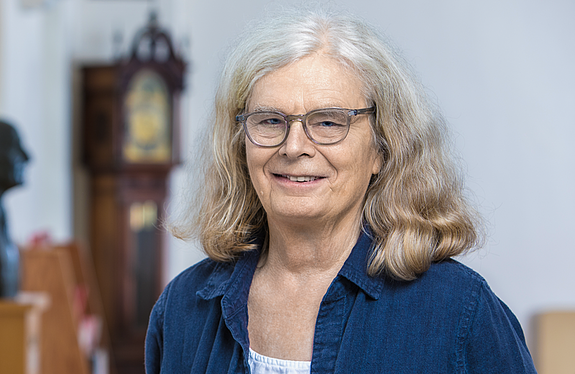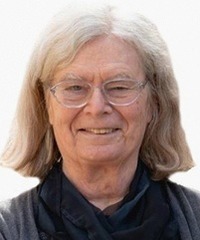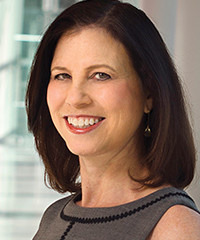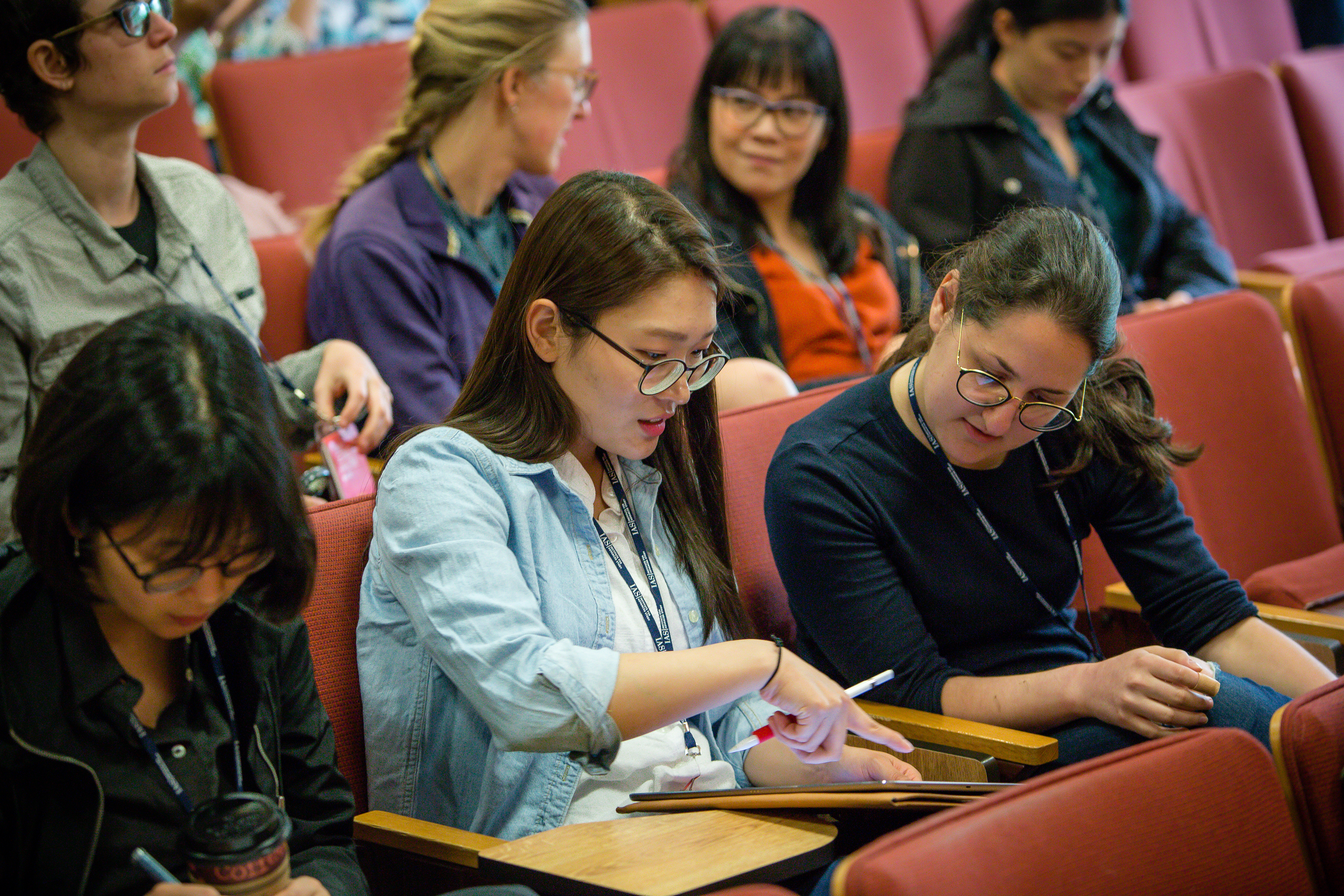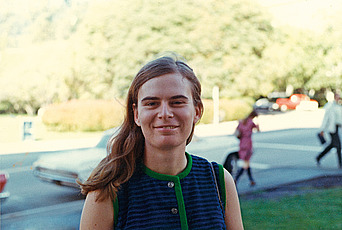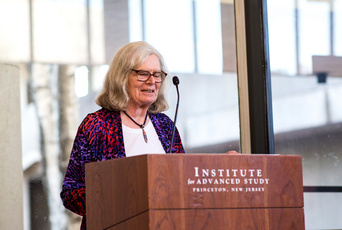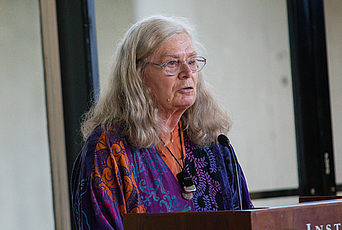Karen Uhlenbeck is Distinguished Visiting Professor in the School of Mathematics at the Institute for Advanced Study. A founder of modern geometric analysis, she is professor emeritus at the University of Texas at Austin and was named a MacArthur Fellow in 1983. At IAS, she cofounded the Women and Mathematics Program to recruit and retain more women in mathematics. She spoke with IAS’s Distinguished Journalism Fellow Joanne Lipman about her pioneering path and how elevating the role of math in society would help solve problems such as the Covid pandemic. This conversation was conducted on May 5, 2020. It has been edited for length and clarity.
Joanne Lipman: Last year, you won the Abel Prize, which is considered the Nobel Prize of mathematics. I was struck by how, when you won, you said you had no role models except Julia Child.
Karen Uhlenbeck: And I’ve thought of another one, which is Virginia Woolf.
JL: Can you explain why?
KU: Well, first of all, I didn’t know about any mathematicians when I was growing up, and the question is, when I was fairly young, who did I take as my role models. I was an avid reader and everybody watched Julia Child. Both Julia Child and Virginia Woolf were big contributors to my world view, so to speak.
JL: Is that because they were women who were prominent in a field?
KU: Well, their personalities were out there. I think that’s much more important. They both have large personalities, and they were public figures, historical figures, that I could associate with. From a very young age I wanted to be part of the intellectual world.
JL: Did you want to be a mathematician when you were younger?
KU: No. Actually, I’ve thought about this question a lot. I didn’t really think of myself as wanting to be anything. I wanted to learn about things, and I wanted to understand things, and I also liked to do things, meaning, you know, hike and garden, and I read immensely, and so forth. But I didn’t think of it in terms of succeeding in a profession.
JL: I would imagine at that time, women weren’t being encouraged to go into professions.
KU: That is true, that women weren’t encouraged to go into professions. But in fact, whenever teachers met a good student, they always encouraged them. That’s just something built into the system. I was encouraged because I did well.
JL: When did you realize or decide that you wanted to pursue mathematics as a career?
KU: Not when I was in high school. I actually was quite interested in physics at the time. And I also read some popular literature. I remember the book by George Gamow, One, Two, Three, Infinity. I think that was my first mathematical achievement, to understand the differences in the kinds of infinities there are. I really liked that satisfaction of understanding why there was more than one kind of infinity. It was only in college that I started to study mathematics seriously.
I have to confess that if I had any goal when I was growing up, it was not to do anything that involved dealing with people, which I always found difficult. [Laughter]
JL: Once you decided on the course of mathematics, did you encounter any obstacles?
KU: There were obstacles, but I keep on coming back to the fact that I was a very good student, and I really was encouraged by teachers. I think perhaps it’s because I was such an inward-turning personality, I don’t actually recall any problems of that sort.
Of course, I couldn’t apply to Princeton because they didn’t accept women. But I was encouraged. I think this was partly Sputnik, in the sense that it was felt that we really needed a scientific workforce, and that they explicitly said women and minorities were encouraged, because we need you. I think you’ll find many mathematicians of my generation were very much encouraged by this attitude coming from Sputnik, that they really wanted us. They needed people to do this kind of work. And that was encouraging.
JL: After you earned your undergraduate degree from University of Michigan in 1964, did you encounter barriers in graduate school?
KU: I went one year to the Courant Institute. I was partly attracted to the Courant Institute because I had a boyfriend there, but it was also because the mathematician Lipman Bers had been there. Bers had been at the Courant Institute at NYU for years, and was the attraction, the person who mentored the most women mathematicians of my generation, of anybody around.
He was really very encouraging to women. And so I knew that that program was actually welcoming to women, and that was part of my decision to go there.
JL: Why did you leave after one year?
KU: I got married, and my husband was in biophysics at Harvard. It’s a very interesting insight into my personality that I didn’t apply to Harvard or MIT, although I had an NSF graduate fellowship, and they probably would have taken me. But I was not interested in entering into questions about women, and I knew that I would find them there. So I went to Brandeis. It was a very good choice. I had a fantastic advisor, and I had a really good experience as a graduate student at Brandeis.
JL: I gather that at the time, as with Ruth Bader Ginsberg, there was no thought that your husband should follow you. The woman always followed her husband.
KU: Oh yes. I actually finished a year before my husband, and I had a one-year job at MIT, which I remember I barely got, because they hired me at the last minute, and not in a named lectureship or postdoc. Then when my husband was applying for jobs, it was a bit dicey, but I did get a job at Berkeley where he had gotten a job.
JL: When was that?
KU: It was 1969. I was there during the Vietnam War. And in the height of issues about women surfacing. The most amazing thing to me is that with all this fuss about women, and the Vietnam War, and all these things going on, I actually did quite a bit of mathematics. Those years—going to Berkeley, going on to the University of Illinois, changing jobs, getting divorced—were personally ones of complete chaos, and I still did mathematics, which is something I don’t understand.
JL: What kind of mathematics were you doing at that point?
KU: Well, I got involved in something called global analysis, which was applying techniques from infinite dimensional manifolds to partial differential equations. Basically, it was a matter of applying one kind of mathematics to another, bridging two different subjects. Those were very productive years for me.
JL: Your subject matter obviously is complex, beyond the understanding of lay people. Yet you’ve said you don’t believe it when people say that they don’t have a mathematical mind.
KU: That’s right. I don’t believe it.
JL: Why is that?
KU: What it usually comes down to is at some point in their education they couldn’t understand why something was true. And the math teacher at the time, said, just believe it. That’s the rule. You do it that way because that’s the way you do it in mathematics.
And of course, that’s a terrible way to teach somebody mathematics, because if you’re at a stage where a person wonders about something, there’s probably something to wonder about. There’s probably a subtle point, and the teacher is very often just teaching it by rote.
I’ve taught mathematics now for 50 years, give or take. And no two minds of mathematicians are alike. So what must it be like for the general population? People think so differently. Mathematics is something that if you were lucky enough to have the kind of mind that the training was geared at, then you got it, and if you had a different kind of mind, the questions you were asking were probably completely reasonable. But the teacher didn’t know enough to help you.
JL: What are you working on now?
KU: I’m working with a former Ph.D. student of mine, who is a professor at Brown, George Daskalopoulos. We’re trying to connect two different kinds of technical theorems and analysis with an idea in topology. We’re using one subject to take a new approach to another, which is my favorite way to do mathematics. I have no idea what will come out of it, which is why it’s so interesting.
JL: Does the pandemic impact your work?
KU: There’s a wonderful story about Einstein, working out the bits about relativity in the middle of World War I, when he was sequestered and ill in Berlin, and sick, and miserable, and didn’t have enough to eat. And that’s when he did his work on general relativity. That came to mind during this pandemic. I mean, I have it easy compared to most people.
What’s also come to mind is the fact that in Soviet Russia during the period when life was so difficult, the mathematicians produced great mathematics. And being in this pandemic, I sort of understand how the desire to get rid of the outside world and concentrate on the mathematics is what’s saving me, in some sense.
JL: It seems that in elite math circles, creativity plays an enormous role, because you have to think beyond what we already know.
KU: Certainly.
JL: That makes me wonder about the limits of computer-facilitated mathematics. Is there any kind of math that the human brain can do that a computer cannot?
KU: Oh, yes. A computer can only follow instructions. There are some mysteries, like nowadays with deep learning, the computer is doing what we basically told it to do, and we don’t understand how it’s doing it. But that really is because it’s working on so many calculations at once that we don’t have any idea of exactly how those calculations are going. But somebody had to tell the computer what to do.
JL: What about in terms of the mathematical modeling? With COVID modeling, every day there seems to be a different calculation about what is the morbidity and how long the pandemic will last.
KU: It’s random information coming out of a random set of computer algorithms, some of which are better than others. They probably don’t have the right information. I’d be willing to bet those computer programs would do a lot better on good data.
Many of the programs were not developed to study pandemics. There are, however, classical models. In fact, I remember teaching the SIRS model for epidemiology in my calculus class. Yet it’s not something that we put a lot of resources into, quite honestly. We will. It just may take a little while to develop it. There’s a time problem here.
JL: As a society, do we not value mathematics and mathematical modeling enough?
KU: Yes, and I think it’s crazy not to value it. It’s funny. I went to the National Academy meeting online, and I went to two sessions, one on the COVID epidemic, and one on black holes. And the COVID scientist talked about how in order to overcome this we had to get all our science together, and we had to do it all over the world, because we could not separate one part of the world from the next.
And then I went to another program on black holes. What the scientists have done to make images of black holes using telescopes all over the world—the tons of data that was exported from Antarctica, which was only one piece of this immense problem—it was put together to see black holes. Scientists can do it. We can do absolutely amazing things.
JL: That’s such a great insight. We’ve worked together globally on the issue of black holes, yet we haven’t had nearly the same amount of cooperation to solve pandemics like COVID.
KU: The truth is that when I came out of that session, I thought, well, you know, people could handle this pandemic. If we can look at black holes, we can solve this problem of pandemics. We could. We have it in us to do it. But so far we’re not.
